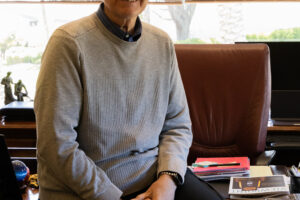In the past several days, two protests occurred at Point Loma Nazarene University regarding the actions of the Provost, Kerry Fulcher, who recently dismissed – some say fired – the Dean of the School of Theology, Mark Maddix. The issue, according to sources, is that Maddix was told by the Provost that he could not hire a former adjunct professor and former Nazarene pastor, Melissa Tucker, to teach as an adjunct again because of her pro-LGBTQIA+ views. Maddix told the School of Theology and Christian Ministry what Fulcher had said about Tucker, according to sources, which Fulcher viewed as “insubordination.”
The controversy hinges on the Church of the Nazarene’s stance on how to view LGBTQIA+ issues. But what is that stance, and why is it the center of so much attention?
This past weekend, the board of general superintendents at the Church of the Nazarene issued a statement clarifying the essential doctrines of the Church of the Nazarene. The covenants of Christian character and the covenant of Christian conduct within the Nazarene manual have been moved to become essential doctrines, including the manual statement on human sexuality, according to Ron Benefiel. This is the first time in Nazarene history this change has been made, Benefiel said.
In an interview with the Point, Benefiel, a member and minister of the Church of the Nazarene, and the director of PLNU’s Center for Pastoral Leadership, offers some explanation on recent events.
“It’s my understanding the reason that they needed to elevate those to essential doctrines is because there’s ambiguity. With that ambiguity — like a difference between essential doctrines, the articles of faith and other things in the manual — some people felt they could decide whether or not they wanted to believe some of the things mentioned in the Manual. For some this may have included whether or not they agreed with the statements on human sexuality,” Benefiel said. “So, in order to clarify because there was enough confusion on this issue, they said, ‘You know what we’re going to do? We’re going to make all of those, all of that, not just take the LGBTQ issue and elevate that, but all of that (the two covenants) and make all of that essential doctrines.’”
Benefiel made it clear in the interview that he will be using the Nazarene’s handbook terminology for clarity purposes in this discussion of human sexuality. The language specifically used in the manual regarding human sexuality that is not heterosexuality is “Sexual activity between people of the same sex.” See the PDF below to read the Church of the Nazarene’s statement on human sexuality.
Additionally, this Q&A focuses on the Church of the Nazarene manual and does not include PLNU’s student handbook or the faculty’s community life covenant, which professors must agree to each year when contracts are turned in.
The Point: What is the history behind the Human Sexuality and Marriage section of the Church of the Nazarene Manual? When was it implemented?
Ron Benefiel: In the past, there has been a fair amount of substantive conversation on this issue. For me personally, I have pastored in downtown Los Angeles, the founding church of the denomination (First Church of the Nazarene). It was located in downtown LA in between West Hollywood and Silverlake, the two predominantly gay neighborhoods of LA. There were a lot of people who were same-sex attracted [and] LGBTQ who participated in our conversation in our congregation. We were wrestling with it then. I have files and files and lots of work that we did trying to wrestle through that. It seemed easier at that point to have the conversation, even though it was taken for granted in the church that homosexuality was a sin. The language in the manual was, ‘abomination.’
Over the years, I’ve had the opportunity or, I should at least say, there was real, substantive conversation and dialogue with theologians [and] biblical scholars, and that led into the general assembly establishing a taskforce and the general superintendents appointing people to a taskforce that eventually led to this statement on human sexuality. It was passed and included in the manual fairly recently at the last general assembly.
The taskforce was a global taskforce. There are very few denominations that have a global organization of one church that is global, under one administration. That means that the global voices in the church have just as much say as American voices, where the church began. The global voices tend to be more conservative on these issues, especially in Africa and Latin America. So, this is a statement that was crafted by a global taskforce that takes into account where the church is on this globally and taking seriously and respectfully not only the voices in Europe — which tend to be more progressive — but also Africa and Latin America. The other thing to mention about this statement is that it is a statement on human sexuality that has theological development. And, the statement on homosexuality or LGBTQ is not a stand-alone statement about LGBTQ. It is part of a broader statement on human sexuality.
TP: What is the purpose in having this [human sexuality] section part of the manual?
RB: This statement is basically seen as something that is much more redemptive than what the language was on homosexuality in the manual prior to this statement. There is certainly an interest in wanting to address this issue and rather than it being just ‘homosexuality is a sin’ to have it in the context of God’s intentions for human sexuality and how that’s lived out in our lives and how the church engages people who are same-sex attracted as welcoming. All of that language is much more redemptive than what the language was before. It’s really a move to being more redemptive as opposed to just, perhaps, judgemental.
TP: With these changes of amending the language or even now elevating [sections of the manual to be essential doctrines], who decides that?
RB: The organization of the church: There are districts. We’re on the Southern California district. There are regions which is U.S./Canada. Then, there’s global. The global church elects six general superintendents. Those are the chief elected officers of the church. There’s also a general board that meets every year. The reason I mention that is Bob Brower is the president of the general board. He’s one of the most influential figures, certainly as a lay person, in the Church of the Nazarene. It puts him in a little bit of a challenging situation with all of this.
The general assembly, which meets every four years from all over the world, will be meeting in June in Indianapolis. It’s like 1200 to 1300 delegates from all over. So that’s the group that legislates things that end up being in the manual. The general superintendents will take things that have to do with theology, like something like this, and then appoint an articles of faith committee to work with the issues of theology and then report to the general assembly.
TP: So you would say alterations to the manual are made every four years at these meetings if they’re needed?
RB: That’s right. There are some exceptions to that but more or less that’s the case.
TP: Was the segment about homosexuality in the manual revisited when same-sex marriage became legal in the U.S.?
RB: It would have been prior to six years ago, so it would have been prior to this statement coming out. The statement coming out would’ve had that to take into consideration. However, this is a global statement so it might not matter that much in writing a global statement when gay marriage became legal in the United States.
TP: In the section regarding homosexuality, it states, “We recognize the shared responsibility of the body of Christ to be a welcoming, forgiving, and loving community where hospitality, encouragement, transformation, and accountability are available to all.” How has the Church or the Nazarene navigated conversations regarding welcoming LGBTQ people while also making it clear your doctrine?
RB: This statement was certainly a move in that direction. In terms of implementing, I don’t know that I can think of anything in particular where that was implemented as much as something that was a general statement that churches should be welcoming and redemptive. Not only is that not implemented, I think it’s safe to say that once this committee finished its work, which was doing a lot of substantive work, that conversation has not continued in any official way in the church. The committee finished its work, and then the official substantive conversations didn’t continue after that.
There is a tension between having a position that states that ‘homosexuality is not ordained of God’ and at the same time being welcoming of people who are same-sex attracted. So that ends up, for some pastors, feeling like a double message or maybe for some people who are LGBTQ that they are welcomed but their sexual orientation is not approved, so it’s a ‘yes-but.’ It may be the best that the church can do given its position that this is not ordained of God, but, also wanting to be hospitable and redemptive. And so having to live in that tension, that’s lived out in different ways and in different congregations.
TP: What are the theological grounds for this statement and for current discussions?
RB: Let’s talk a little bit about how the church gets to this theologically. The idea is out of epistemology — how do we know what we know? How do we know what is true? From a Christian perspective as part of a Christian community we don’t just [say], ‘This makes sense to me.’ We’re part of a community that has tradition and has been thinking about these things for hundreds of years, thousands of years. What does it mean for us to call ourselves Christians? It’s not just whatever we want it to be. It’s part of a community that has theological depth to it. In the Church of the Nazarene, there’s what’s called the Wesleyan quadrilateral — how do we know what we know? There are four pieces to that and quadrilateral is probably a misnomer because it’s not four equal sides. Those are scripture, tradition, reason and experience. In the Wesleyan tradition which the Church of the Nazarene is part [of], this scripture has always been elevated as the highest authority. So how do we know what we know as Christians? It’s not just what we think or what I personally believe, it’s more from a Christian perspective how God has revealed what is true.
There are two ways that God has revealed that: one, in the person of Jesus Christ as best understood through scripture and the other is through creation. We see in creation the majesty and creative genius of God. In these four ways, they are in a dynamic tension with one another, but scripture is always held to be the highest authority. We also look to reason, experience and tradition. From the traditional point of view, there are about six passages in Scripture that mention homosexuality. Probably the most important one is in Romans 1. And those passages are the only ones that directly reference homosexuality, and none of them are affirming. In fact, they are basically saying this is not ordained of God.
What’s also pointed out is Jesus never addresses this issue.
That exegesis, however, in current biblical studies, that exegesis is called into question first of all on the whole of scripture that is the love of God and the redemption of God, and it’s also that homosexuality culturally and contextually was a very different thing in the time of Jesus than it is today.
When scripture mentions homosexuality, it is not in the context of mutual commitment to love in something that would look like marriage. So, that wasn’t even a possibility in the time of Jesus, and a lot of the social dynamics of homosexuality in the first-century may have been very different compared to our current context. So, there’s debate about it.
Those who are on the traditional side would say, ‘But this is what scripture says on the face of it. There isn’t anything that would open it up to other passages that say this is approved by God. And, more importantly, it’s the position that the church, not just the Church of the Nazarene or the Wesleyan tradition, but all of Christianity has taken for 2,000 years for the most part.’ So this is where how we understand what is true is also supported by tradition.
But those who challenge that say, ‘But the church was wrong on some things, like slavery or women in leadership or a number of other things. We have more information now (reason and experience). We have science.’
Those on the traditional side would say, ‘Just be careful with that. Don’t throw away 2,000 years of the way that the church has interpreted the passages. You can’t just easily dismiss that.’
But there is new insight because there’s science that they didn’t have access to when the scriptures were written that has to do with genetic predispositions, patterns, hormonal differences, other kinds of contextuality. Both nature and nurture that combine to form people in the discovery of their identity as opposed to something that they are choosing to be in an act of rebellion to do against God. What about science?
What the traditional would say, ‘Science is not conclusive. There are identical twins where one is gay and the other is straight. It’s not conclusive.’
And then there are those who would say, ‘But this doesn’t make sense to me because I know people. My daughter came out and she is a person who loves God and loves people and has exemplary character. And certainly, God is not judging that.’
Those in the traditional side would say, ‘That’s not for us on our own reason to decide. What we’re trying to do here is to understand what God is saying about this and how God made us.’ Sometimes the illustration is given that you can have a genetic predisposition towards alcoholism and that’s not ordained of God. The gay community generally hates that illustration in that it equates their sexual orientation with an illness or addiction.
In the Wesleyan quadrilateral, how we know what we know, those pieces [scripture, reason, tradition and experience] end up being the ongoing debate. It’s not just a cultural response or not just sort of holding on, it’s an ongoing debate. This is what I, personally, would hope for for the future: mutually, respectful substantive dialogue. Where is the mutually, respectful, substantive dialogue? The difficult thing in this environment is people are already, for the most part, already so convinced of their positions whether it be traditional or progressive that it’s hard to respect the other side and say, ‘Okay, let me understand what your saying.’”
TP: Can ministers or leaders be affirming of homosexuality? Is there a penalty if they are affirming and the church disagrees with their stances? How are the ‘essential doctrine’ changes affecting that now?
RB: This is what’s coming down now. Those who are affirming in the Church of the Nazarene and [are] ministers still would not go against the church’s position of, for instance, marrying a same-sex couple. So, that would clearly be something a minister in the church of the Nazarene could not do, or, perhaps even to bless a union. So that has remained in place.
TP: Are people in the LGBTQIA+ community allowed to have leadership roles like leading worship, helping with child care, in the Church of the Nazarene?
RB: Yes, all of that if they are celibate and commit to being celibate. That would be consistent with people who are heterosexual single. The logic of that is that the only God-ordained expression of sexual intimacy is in the context of marriage between one man and one woman. Anything beyond that whether it be homosexual and heterosexual would be reason to not be able to serve in leadership in the church.
TP: Do all Nazarene institutions have to implement the entire manual in their community living conducts? Which sections are non-negotiable?
RB: There was a time when some of the documents, there were legal documents of Point Loma, referred to the manual of the Church of the Nazarene. But for accreditation purposes, that link had to be severed. That was actually not appropriate. So Point Loma Nazarene University is affiliated with the Church of the Nazarene, not owned by the Church of the Nazarene. The Board of Trustees elects its own trustees. So those are not elected by or appointed by the denomination, even though the Board of Trustees has in their bylaws, or at least norms that almost all of the Board of Trustees are active members of the Church of the Nazarene. I think all of the Nazarene universities in the United States are legally separate from ownership by the denomination.
TP: So how much of the Nazarene Manual would you say impacts these institutions?
RB: Well they’re affiliated with the Church of the Nazarene. The Church of the Nazarene founded these institutions, supported these institutions. There were leaders in our own history here who mortgaged their own homes or when there wasn’t enough money, paid the salaries of faculty members to keep the thing afloat. There are all of these stories. So, there would not be a Point Loma Nazarene University apart from the church, going back to the reason for founding and the relationship. But, that relationship is different now than it would’ve been a few years ago for a variety of reasons. So, it is affiliated with the church, but it is not owned by the church. In that sense, it is self-determinative, and yet the ownership of the school is the Board of Trustees, which is mostly Nazarene.
TP: Moving forward with the changes that may be happening regarding the elevation of the statement [to be an essential doctrine], what do you think will happen?
RB: We don’t know. I’m getting emails. I’m going to be in a Zoom call after this is finished with some key people in the church who are trying to process this as they’re talking with other people. I’ve had numerous conversations just this weekend. This is all sort of bubbling right now, and we don’t know. But I am encouraging people to wait. We don’t know. So let’s not jump to conclusions. Let’s wait to see how this plays out. The church is not wanting to alienate people. I do have a statement from a church official: ‘We are not trying to take rights away, simply we believe that God is calling us to live a particular way.’ And so, how this plays out, we don’t know. The church leaders are trying to say, ‘This is our position, and we need to clarify. We’re not trying to come down hard, but it’s going to be heard with the clarity as coming down as pretty hard.’
TP: I’ve talked to a few people who have mentioned they’re nervous about what the penalty could be if they’re investigated or seen as not being in line with this elevated status of the human sexuality statement [to be an essential doctrine].
RB: We simply don’t know. We just don’t know. What we do know is, actually now for the past several years already, those who are being ordained as elders or ministers are asked if they are in harmony with the church’s position on homosexuality. That could be interpreted in different ways: Are they willing to support the church’s position on this? The new statement seems to be more direct. We don’t yet know what this will mean.
TP: How does [Thomas Jay Oord’s new book titled “Why the Church of the Nazarene Should Be Fully LGBTQ+ Affirming”] that fit into this conversation that is happening at the higher levels of the Church of the Nazarene? How is that going to play out?
RB: We don’t know. It may be his exit strategy from the denomination, he already went through a church trial. And [he] was exonerated on this issue. But now this [book] is taking it another step. It’s 500 pages with 90 essays. And so what are going to be the implications of people who have submitted essays to this book at a time when the general superintendents just issued a ruling that elevates the statement on human sexuality to an essential statement on the doctrine of the church? We don’t know.
How do we clarify and explain what the Church of the Nazarene’s position is on this? Well, it feels different right now than it did a week ago.
Written By: Lainie Alfaro








